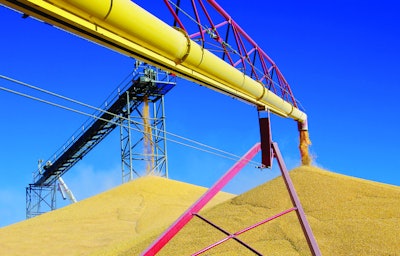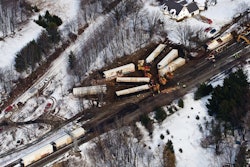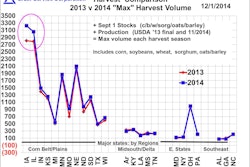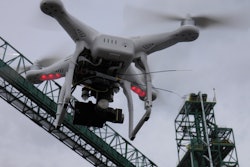
Roger is the general manager of a fictional large country elevator shuttle-loader located in the Western Corn Belt.
“This season is starting off great! Look at this list of scale tickets — and harvest is barely underway.” Roger sat quietly in the elevator’s conference room, enjoying the sight of trucks pulling onto the scales.
Delayed Pricing (DP): Rules of the Road
|
“What great problems to have — sure beats last year.”
Barbara, the elevator’s grain merchandiser, swiveled around in her chair and eyed Roger.
“I agree, Roger, but we have some decisions to make. Everyone has underestimated just how big the yields are, and we’re going to have to sell a lot more soybeans to free up two more tanks for corn. Some quick ship premiums on soybeans to the crusher are still around, and I’m selling small lots of truck beans as fast as we receive them, but those premiums will be gone in days. For us to move any serious volume we have to sell trains. Fortunately we learned our lesson last year, and I booked three turns early on a shuttle train for October and early November.”
Roger smiled in agreement, but then paused. “We don’t have any bean trains sold yet, and I’m not sure we’ll buy enough to fill two trains. With futures back below $9.50 and cash prices under $9, farmers aren’t selling much and I’m not sure they’ll change their minds now. What’s your game plan, Barbara?”
She handed a printout to Roger, and said, “DP — Delayed Price Inventory. We have to make sure farmers know they can use DP instead of automatically wanting to go into storage.”
“OK, show me your numbers,” said Roger. “What service charge will we have to post on Delayed Price to make this work.”
Barbara looks at page one. “Our storage rate is 18¢ to January 1 and then 5¢/month ($.00165/day). We haven’t changed that rate in years and farmers are used to it. And we often set the DP service charge the same as storage on soybeans — as long as we can keep the beans in the tanks. That way we can sell soybeans when basis firms up after harvest. In recent years the DP service charges and futures inverses have covered any potential basis loss from selling before the farmer prices. But this year is different; we’d be selling basis in October, so I worked up some scenarios for you.”
Barbara walks over to the conference room white board and picks up the marker. “OK, here goes. It comes down to car costs and whether we absorb them or pass them on. Assuming the PNW remains our market through early summer, selling DP soybeans in October is actually a good strategy in terms of basis. As I see it, if we sell DP soybeans in October and the farmer prices them with us sometime between March through June, we stand to make 20¢ to 30+¢ on top of our usual back-to-back bid margin, and that’s with zero DP service charges.” (See chart on pg. 44, Line 7)
Roger leans forward and says, “Come again?”
Barbara continues: “Things can change, of course. I’m using current and forward PNW bean bids through June, and maybe later those deferred values turn out to be a lot higher when farmers are pricing DP bushels. But South America has most of the export market by summer; the PNW’s current June bid of +150 July is probably high.”
Barbara sketches out more numbers on the white board. “Basis for October is +205Nov vs. +180Jan for January and +150July for next June. Basis drops more in the forward months than the futures carries cost us, so we come out ahead selling now. AND we can earn 5% interest for three months (Nov/Dec/Jan) from using the sales proceeds to reduce our borrowing. But after January we probably won’t be borrowing much, so I’m not including any additional interest earnings past January. (Table 1, lines 1-6)
I can set spreads to eliminate spread risk. Our base rail rate doesn’t change and fuel surcharges probably won’t rise in the near term. The big variable is the cost to buy freight in the secondary market to be assured we can ship. It would cost us $4,000/car to buy freight today for Oct/Nov, over $1.10 per bushel (Line 8). I estimated the car cost for waiting and shipping in January at $3,000/car, and $1,500 by June (Line 10). The higher cost for October has to be charged against the basis gains, which changes the picture a lot.”
Barbara looked over to Roger.
“But we have three shuttles bought for Oct/Nov,” Roger replied.
“True,” Barbara said, “but I could sell those out today for $4,000/per car; if we load them we’re passing up $4,000 times 110 cars,” Barbara countered. “If we had space we could wait and ship the beans later when cars cost less, so there’s a trade-off between basis and freight. Let’s work through it. If we do not pass car costs on to the farmer, selling DP beans right now loses 73 to 90¢ (Line 9). But if we wait and ship later, the cheaper forward car costs will reduce those losses (Line 10) to “only” 42 to 83¢. So as I see it, the loss from shipping in October is the higher car cost, Line 11.
“In this example, DP service charges of around 30 to 35¢ by spring/summer, plus the basis earnings, will offset our car cost and we protect our back-to-back margin of around 15¢. But we need to do better than that. On the other hand we’ve freed up the bin space here in October to refill with something else that earns revenue. Bottom line: I suggest a soybean DP rate of 25¢ minimum for 30 days, then 5¢/month thereafter. That would generate around 45¢ of DP service charges by March, or 60¢ by June, to offset our costs.”
Roger interrupts, “But with the DP rate higher than storage, farmers won’t opt for DP.”
“Agreed, Roger, but we simply don’t have room to take all the soybeans in on storage and comply with warehouse regulations. For some folks it’ll be DP or they have to sell,” replied Barbara.
“OK,” said Roger, “but let’s cut the minimum to 20¢ and go with it. Good job!” ❚
What is the gain or loss from selling Delayed Price soybeans in October? |
|||||
| Line: | Time slot: | October | January | March | June 2015 |
| 1 | Today’s bid: | +205Nov | |||
| 2 | + Futures carry | -7 ½ Nov/Jan | -15 Nov/March | -28 Nov/July | |
| 3 | +205 November is equal to: | +198Jan | +190March | +177July | |
| 4 | +Interest earned | +11¢ | +11¢ | +11¢ | |
| 5 | Line 3+4 Adjusted October sale = | +205Nov | +209Jan | +201March | +188July |
| 6 | Today’s forward PNW bids: | 0 | +$.29 | +$.21 | +$.38 |
| 7 | Gain or (Loss) selling in October & buying later. Line 5-Line 6 | ($1.11) | ($1.11) | ($1.11) | ($1.11) |
| 8 | - October car cost | ($1.11) | ($.82) | ($.90) | ($.73) |
| 9 | Net loss by selling in October | ||||
| Compared to selling later | ($.83) | ($.55) | ($.42) | ||
| 10 | Est car cost in forward slots: | ($ .01) | ($.35) | ($.31) | |
| 11 | Selling in October vs. waiting: | ||||
|
Line 4: Interest at 5% on $9 until January; no additional earnings after that. Line 9 = Line 7 minus Line 8 Car costs are all in $/¢ per bushel. Line 11 reflects the October car cost compared to forward car costs. |
|||||
Hypothetical performance results have certain inherent limitations, and do not represent actual trading. Past results are not indicative of futures outcomes. Trading futures involves risk of loss.


















